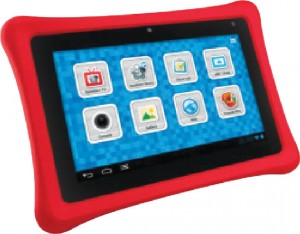Touchscreens and virtual reality open new windows for autistic children
Autism experts feel that touchscreen technology is a boon to children with Autism Spectrum Disorder (ASD), as it helps expand their skills and explore new worlds all at the touch or even bang of a button! Of late, we saw a lot of groups developing smartphone-based apps and devices for young children with autism.
Access4Kids, for example, is a wireless input device for children with fine motor impairments. Developed by Ayanna Howard, Giancarlo Valentin and Hae Won Park from Georgia Tech, the device may be worn on the forearm or placed on a wheelchair arm. It includes three force-sensitive resistors that measure pressure from physical movements such as rough hits or swipes, and converts them into fine-motor gestures that translate to touchscreen commands.
Coupled with an Android-powered tablet computer and a special software stack, it becomes a holistic therapeutic system for children lacking upper-body control. The open source software library developed by the team is a critical component of the system, as it enables the kids to access popular applications like Facebook and YouTube as well as custom-made apps for therapy and education. The first prototype has been successful, and clinical trials are likely to begin this year.
This year’s Consumer Electronics Show also showcased several products with features that could be used by autistic children too.
One interesting example is Big Bird’s Words, which could help parents of special children to convert nightmarish shopping trips into fun-filled learning experiences. The outcome of collaboration between Sesame Street and Qualcomm, Big Bird’s Words lets kids use their parents’ phone to scan the world around them for printed words. Big Bird then helps them learn to read by sounding out the first letter. For example, when you go shopping, you could get the kids to match the items on your list (preloaded into your mobile as images) with the boards on the shelves. The game starts by asking the users to pick a word with an associated image. The users then have to find that word in the real world by pointing the camera of the device at the text.

www.nabitablet.com)
Nabi 2 is a tablet with an integrated learning system that helps parents of autistic children to gain better control over the time that the kids spend with technology. The tablet has features such as the Chore List and Treasure Box that integrate incentives into a child’s playtime.
Nabi 2 uses a basic token system in which predetermined chores are set. The list can be changed over time as kids finish playing with the loaded activities. It also allows parents to use a timer that prompts children to hand the tablet over to a parent or sibling after a configured duration of time is over. This is very helpful in the case of autistic children, because once they get comfortable with a technology there is a constant fear of them getting addicted to it.
Another interesting product is NeuroSky’s Focus Pocus—an interactive game controlled by the player’s brainwaves. Priced less than $100, the goal of this product is to help people with concentration problems, especially children with Attention Deficit Hyperactivity Disorder (ADHD), to improve their impulse control, attention span and memory. The device utilises EEG to read brain wave states, electrophysiological activity and metabolic rate—and converts changes in these into instructions for the play characters to follow. Hence the children have to concentrate in order to get the characters to do what they want.
However, it is important to note that great care has to be taken while developing tools for special children—as one problem could lead to another. At last year’s Icare4Autism’s International Autism Conference, Professor Tamar Weiss of the Haifa University expressed her concern that while kids are attracted to technology and it could help them discover new concepts, it comes with a huge risk of them becoming glued to the devices for long hours ignoring social interactions—which is indeed more important for such kids. She explained that the trick is to devise games or activities that can be played on accessible touchscreen devices but involve more than one player. Her team, along with another at the University of Trento, is using Mitsubishi’s touchscreen table, to devise several activities and puzzles that will draw autistic children out of their shell and improve their social skills by encouraging them to play in teams or with more than one player.






